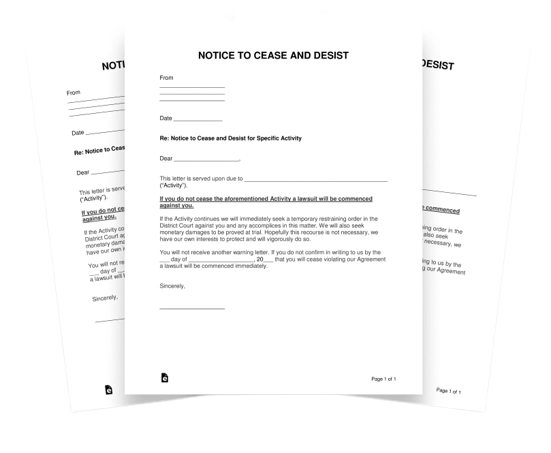Distribution Agreements
Insights and strategies for maximizing the advantages of distribution agreements while reducing the risks, from comprehending the legal framework.

Download a Distribution Agreements template
Created and approved by the experts at CMI Group for your use.

Download a free Cease
and Desist letter template
Created and approved by the experts at CMI Group for your use.
Distribution agreements are an essential part of many businesses’ development strategies because they give them a way to reach new markets and boost sales. These agreements, however, can be intricate, requiring careful evaluation of both legal and financial issues. We will discuss advanced factors and best practices for navigating distribution agreements.
We will provide insights and strategies for maximizing the advantages of distribution agreements while reducing their risks, from comprehending the legal framework and resolving common issues to identifying risks and hidden costs. We will also go over the significance of choosing the appropriate vendor and forging a cooperative relationship. This will offer helpful tips to help you negotiate the complexities of distribution agreements, whether you’re a business owner looking to broaden your customer base or a distributor trying to forge productive partnerships.
Get a Distribution Agreements template created by CMI’s expert Lawyers.
Legal Considerations In Distribution Agreements
Distribution agreements do not come in one size suits all. Any agreement should have certain fundamental components, but it’s also crucial to take into account more complex elements that could affect how well the agreement works. We will look at some of the more complex factors that companies should take into account when negotiating distribution deals in this section.
It’s crucial to comprehend the legal parameters under which these kinds of arrangements are governed before signing a distribution agreement. This includes becoming acquainted with pertinent laws and rules, such as the Uniform Commercial Code and antitrust laws.
Businesses should think about speaking with lawyers with knowledge of the drafting and negotiation of distribution agreements. A properly written agreement that conforms with all applicable laws and regulations can help avert future legal problems and disputes.
Common Problems in Distribution Agreements: Solutions
Exclusive rights, geographic limitations, and termination clauses are just a few of the possible problems that can occur in distribution agreements.
Exclusivity clauses, for instance, may prevent a manufacturer from marketing their goods through other outlets, and territorial limitations may prevent distributors from marketing goods in specific areas. Both of these provisions may limit a company’s ability to develop and thrive.
Termination provisions should also be taken into account. If not properly negotiated, a poorly written termination provision may result in legal disputes and financial losses. A clear grasp of the termination terms and the repercussions of a breach must exist between the parties.
Monopolies are prevented, and market competition is safeguarded, by antitrust laws and rules. These laws can occasionally be broken by distribution agreements, especially if they entail market allocation or price fixing.Businesses should avoid agreements that limit customer choice or competition to ensure compliance with antitrust laws. To make sure that their distribution agreements comply with pertinent regulations, businesses should also think about speaking with legal experts who have experience in antitrust law.
In other words, moving beyond the fundamentals when negotiating distribution agreements can assist businesses in averting future financial and legal problems. Businesses can create efficient distribution agreements that are advantageous to all parties by comprehending the legal structure, dealing with common problems, and making sure they are in compliance with all applicable laws.

It takes a thorough grasp of the legal, financial, and reputational ramifications in addition to close attention to the agreement's advantages and risks to successfully navigate the complexities of distribution agreements. Businesses can successfully negotiate these agreements and make the most of the advantages they offer by taking a proactive approach to managing these risks and setting clear expectations with the distributor.

The possibility for conflicts or disputes between the company and the distributor is one of the major risks connected with distribution deals. These can result from a variety of things, such as divergent marketing tactics, disagreements over payments or prices, or adjustments to market circumstances. Businesses must guarantee open communication with the distributor, set clear expectations, and periodically review and assess the agreement's performance in order to reduce these risks.

The potential effect on brand and reputation is a crucial factor to take into account when signing a distribution contract. Businesses need to make sure the distributor is a good match for their brand, has a solid reputation in the industry, and is able to market their goods successfully. Businesses must also be ready to respond to any damaging effects on their brand reputation that could come from the distributor's performance or actions.

The complexity of distribution agreements must be navigated while taking financial factors into account. Businesses must carefully assess all related costs, such as those for marketing and promotion, inventory control, and logistics. Additionally, they must make sure that their ability to successfully manage cash flow and that their pricing and payment conditions are reasonable and fair.

Lastly, companies need to be conscious of the legal and regulatory issues surrounding distribution agreements. Intellectual property rights, antitrust laws and regulations, and adherence to municipal laws and regulations are a few examples. These legal requirements must be followed or else there could be severe financial fines, reputational harm, and legal issues.

Distribution agreements can be very beneficial for companies, increasing their market reach and sales, but they can also come with a number of risks and difficulties. Understanding the complexities of these arrangements necessitates paying close attention to both shared advantages and shared risks.
Free 15-minute consultation for Distribution Agreement with our experienced lawyers.
The Hidden Costs Of Distribution Agreements
Distribution agreements offer a method to extend a business’s market reach, but they often come with hidden costs that need to be examined. This part will examine the financial effects of distribution agreements and offer tips for successfully negotiating and controlling these costs.
Selecting The Right Distributor For Your Business
Selecting the right distributor is crucial for businesses looking to expand their market reach and increase sales. However, it can be a daunting task, with numerous factors to consider. In this section, we will explore the key considerations for selecting the right distributor and establishing a mutually beneficial partnership.
Got An Issue You Want To Chat To A Legal Professional?
*Free consultation is limited to 15 minute phone call for us to give preliminary advice






